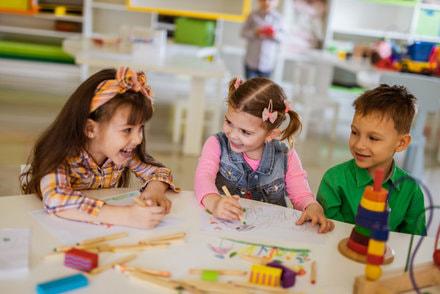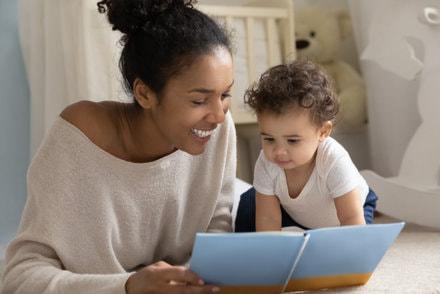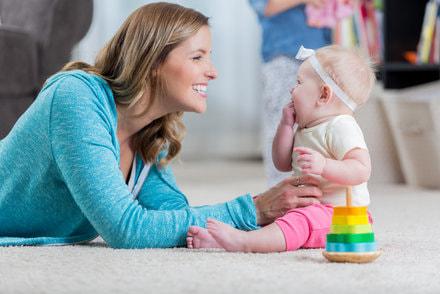Developing early communication skills in children is an essential part of their overall development. From referencing others and using gestures to speaking, these milestones mark just a few of the numerous skills that children will learn as they grow.
Communication skills provide children with the ability to engage, share their experiences and build positive relationships with the people in their life.

What Are Early Communication Skills?
Early childhood communication skills refer to the ability that young children develop to express themselves and understand others. This includes verbal and non-verbal communication skills.
The rate of acquisition of communication skills varies among children, and those with Autism Spectrum Disorder (ASD) may experience more prominent delays in their development, which can be concerning to parents. Children with ASD require additional support to help them learn these skills.
Early communication skills are typically prioritised in early intervention programs, as the development of these skills helps children to independently have their wants and needs met, and as a result, reduce their frustration and challenging behaviour.
How a child with ASD communicates may look a little bit different to their typically developing peers, at least initially. They may be more successful initially learning how to communicate using gestures, signs or pictures.
They may go on to eventually use spoken language as their main method of communication, or they may continue to prefer alternative methods, this depends on each child and what suits their needs best. The main goal is to ensure their wants and needs can be met, their frustration is reduced and they can share their experiences with others.
What Is A Child’s Earliest Form Of Communication?
Early communication skills start from birth. A baby may show signs they need to feed by opening and closing their mouths, hand sucking, moving towards their milk bottle or their mother and showing signs of being alert and active.
The earliest forms of communication include crying and other verbal noises, body movement: for example stiffening or restlessness before they have some milk or moving their arms to show they are excited. Eye contact or reference to people’s faces is another early form of communication, and after a couple of months, babies may develop other facial expressions such as a smile.

Why Are Communication Skills Important In Young Children?
Communication skills help young children share their needs and feelings with their caregivers, they are also a way to connect and bond with those caregivers. Developing a bond between a baby and its caregiver is essential since babies cannot care for themselves and rely completely on their caregivers to survive and thrive.
These skills also show them cause and effect, for example when they cry, they get their parent’s attention. The parents check on them to see if they need a nappy change they are hungry or just need to be picked up and held.
Response and reward is another lesson from early communication skills, for example, if a baby smiles they also receive a smile back. When a baby first starts to smile, the parent will likely also give the baby lots of praise as a reward for their smile.
Communication skills help set the child up for life, enabling them to interact with their peers in daycare or the classroom, as well as create friends and make relationships later in life.
How Do You Develop Communication Skills In Early Childhood?
These types of skills will develop naturally as a result of the child interacting with their parents and other people in their lives. The child will absorb information about the world around them, different sounds from speech, interactions between their parents and carers, body language, tone of voice and much more. In the early stages of their life, children begin to learn by observing and imitating others. They will often engage in back-and-forth expressions, gestures and sounds with familiar others.

There are many activities parents can engage in with their child that can support and increase early communication skills. We will cover a few of these below.
How Can You Increase Early Communication Skills?
There are several ways to support and increase early communication skills in infants and young children:
Playing Games
- Peek-a-boo: This shows the child how to wait and respond when you say ‘peek-a-boo’…
- Pat-a-cake: When they can sit up, combining singing with action and touch is a great way to help a baby pick up words and communicate through movement.
- Anticipatory games: Games that create anticipation and involve the child looking at the person and waiting for the response e.g., “1….. 2….. 3!!!!” Or “Ready… set… go”
Singing
- Singing to the baby at various points throughout the day, for example at the nappy change table. Parents can tell their babies about what they are doing, this helps them to learn and connect words to objects and actions.
- Singing nursery rhymes that they can start to recognise over time is brilliant for babies and young children, babies love repetition and eye contact.
Speaking
- Speaking to the infant or child, telling them about what you are doing “I am going to prepare us a tasty snack”
- Explain what you are doing or why you are choosing an activity. This regular interaction teamed with eye contact can help the child recognise words with actions or objects over time.
- Keep it simple! Rather than asking lots of questions or lengthy sentences, use words and sentences that are realistic and achievable for your child to imitate.
Making Eye Contact
- Eye contact whilst talking, singing and smiling at the baby. This should be natural and not forced.
- During the first few months of life, babies quickly discover that the gaze and referencing of others contain valuable information and that eye contact is the start of joint attention, an important communication milestone. [1]
Gesturing
- Gesturing can help an infant develop an understanding of the meaning of words.
- Pointing to an object whilst naming the object is a type of gesture that may help with early communication skills.
- Other examples of gestures include: waving, clapping, holding up fingers to indicate a number, thumbs up, thumbs down, creating shapes with our hands to signify objects (eg: making a ‘twinkling’ gesture, pointing to the sky or making a diamond shape with your hands when singing Twinkle Twinkle Little Star).
- Research has indicated that there is a connection between the quantity and variety of gestures used by infants and their subsequent language development. [1]
Reading
- Reading to a child can have a significant impact on their early communication skills. Even though they may not yet understand the meaning of the words, they benefit from exposure to a broader range of sounds and rhythms, which can help them develop their language skills. Additionally, the rhythmic patterns and intonations of the reader’s voice can provide a soothing and comforting experience for the infant, helping them to feel safe and secure.
- If your child isn’t too interested in books, adding fingers puppets or gestures whilst reading may help to increase their interest
Listening
- Knowing that the parent, or person speaking to them is interested in what they have to say and participating in a discussion can not only help with their confidence but will help with the parent-child bond. When a child is confident that the other person is interested in what they have to say they are encouraged to practise their speaking and social skills.
Creating An Environment That Supports Communication
- Limiting screen time may improve communication development in young children:
‘an increase in the amount of screen time and the early age of onset of viewing has negative effects on language development, especially for the children under the age of two with older age of onset of viewing showing some benefits’. [2] - Toys, games and books may support child development, for example: by providing dressing-up costumes, figurines or toy objects to encourage role-play and discussion.
- Different experiences, for example going to the park, the zoo, the library or a museum are opportunities to open up different topics of discussion and interact with other people.
What Is Joint Attention? How Can It Increase Early Communication Skills?
A milestone in early communication development is the presence of joint attention between an adult and an infant. Joint attention is a coordinated social interaction, which includes sharing attention (e.g., through the use of alternating gaze), following the attention of others (e.g., following where the other person is looking), and directing the attention of another. [1]
Improved verbal communication skills are linked to the early emergence of joint attention abilities. Typically, infants demonstrate joint attention skills between 8 to 15 months, and those who engage in gaze alternation and direct attention early tend to exhibit a relatively larger vocabulary growth in their early years. [3]
This underscores the significance of joint attention in laying the groundwork for object-word mapping and supporting language development in infants.

How Does Language Development Impact Early Communication Skills?
Language development plays a crucial role in the development of early communication skills. As infants acquire language, they become increasingly able to express their needs and wants, share information, and engage in social interactions with others.
Not only does it influence their social development, but it also influences a child’s cognitive ability, such as; decision-making, problem-solving, learning and thinking or processing information.
It is essential to recognise that early communication skills are unique to each child and can be enhanced through various activities such as conversing, using gestures, reading, playing, and making eye contact. By incorporating these strategies into daily interactions with young children, parents and caregivers can create a nurturing environment that promotes healthy communication development and sets the foundation for successful communication skills throughout their lives.
Finally, sometimes, despite all their efforts, parents may notice a difference or delay in the development of their child’s early language and communication skills. If concerned, parents should seek assistance and guidance from professionals to reduce the chances of their child falling further behind, rather than using a “wait and see” approach.
